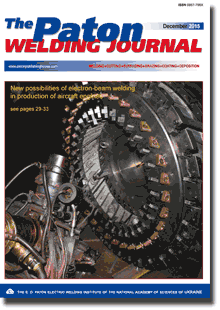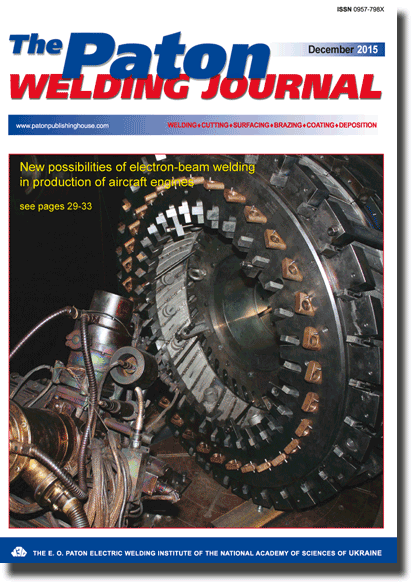| 2015 №12 (03) |
DOI of Article 10.15407/tpwj2015.12.04 |
2015 №12 (05) |

The Paton Welding Journal, 2015, #12, 19-23 pages
On the influence of capacitance in the welding circuit on stability of arc welding mode
G.A. Tsybulkin
E.O. Paton Electric Welding Institute, NASU. 11 Bozhenko Str., 03680, Kiev, Ukraine. E-mail: office@paton.kiev.ua
Abstract
Profound study of the influence of various kinds of destabilizing factors on welding process stability is one of the main tasks in its robotization. The influence of capacitance («parasitic» or purposefully included into the welding circuit) on stability of the mode of consumable-electrode gas-shielded arc welding was studied in this work. It is shown that at high and medium welding currents, i.e. when the working point is located in the rising or flat section of the arc volt-ampere characteristic, presence of a capacitance in the welding circuit does not affect the stability of steady-state arc welding mode. Now, in the case of small currents, when the working point is located in the falling section of this characteristic, ensuring the arc welding mode stability is possible only at limited values of the above capacitance. Established criteria in the form of algebraic inequalities allow comparatively simple evaluation of the region of this capacitance values, within which stable modes are guaranteed. Results presented in this paper will be useful in development of robotic welding technologies and respective process equipment. 17 Ref., 5 Figures.
Keywords: robotic arc welding, consumable electrode, capacitance, steady-state modes, stability, transient processes
Received: 08.10.15
Published: 21.01.16
References 1. Vereshchago, E.N., Kostyuchenko, V.I. (2014) Mode instability in circuit with capacity and electric arc supplied by direct current source. The Paton Welding J., 8, 42-46. https://doi.org/10.15407/tpwj2014.08.07
2. Andronov, A.A., Vitt, A.A., Khajkin, S.E. (1959) Theory of vibrations. Moscow: Ph.-Math. Literatura.
3. Finkelnburg, W., Maecher, H. (1961) Electric arcs and thermal plasma. Moscow: IL.
4. Khrenov, K.K., Esibyan, E.M. (1962) Influence of static characteristics of arc and power source on stability of arc running and mode. Svarochn. Proizvodstvo, 5, 10-13.
5. Paton, B.E., Lebedev, V.K. (1966) Electric equipment for arc and slag welding. Moscow: Mashinostroenie.
6. Leskov, G.I. (1970) Electric welding arc. Moscow: Mashinostroenie.
7. Esibyan, E.M. (1963) Study of electric and technological properties of low-amperage welding arc. In: Coll. on Welding of special metals and alloys, 137-152. Kiev: AN Ukr.SSR.
8. Sisoyan, G.A. (1974) Electric arc in electric furnace. Moscow: Metallurgiya.
9. Ionov, Yu.G. (1986) To theory of non-stationary processes of direct current electric arc. Izvestiya SO AN SSSR. Series Techn. Sci., Issue 1, 4, 84-88.
10. Lenivkin, V.A., Dyurgerov, N.G., Sagirov, Kh.N. (1989) Technological properties of welding arc in shielding gases. Moscow: Mashinostroenie.
11. Pan, J. (1990) Arc welding and control theory. In: Proc. of JWS Int. Symp., 11, 1033-1035.
12. Sudnik, V.A., Erofeev, V.A., Logvinov, R.V. (1999) Study of stability of gas-shielded arc welding process, 110-120. Tula: TulGU.
13. Tsybulkin, G.A. (2008) On the influence of small parameters on MIG/MAG welding stability. The Paton Welding J., 8, 22-5.
14. Tsybulkin, G.A. (2014) To evaluation of stability of same class dynamic systems. Problemy Kontr. i Informatiki, 3, 5-11.
15. Tsybulkin, G.A. (2014) Adaptive control in arc welding. Kiev: Stal.
16. Gritsyna, A.N. (2014) Problems of formation of sound welded joints of thin-walled structures in their welding by nonadaptive robots. In: Proc. of 6th Int. Sci.-Pract. Conf. on Innovative Technologies in Machine-Building and Metallurgy (10 Sept. 2014), 339-350. Rostov-na-Donu: DGTU.
17. Lyudmirsky, Yu.G. (2002) Robotisation in production of low rigidity welded structures. Rostov-na-Donu: SKNTs.
Suggested Citation
G.A. Tsybulkin (2015) On the influence of capacitance in the welding circuit on stability of arc welding mode. The Paton Welding J., 12, 19-23.The cost of subscription/purchase order journals or individual articles
| Journal/Currency | Annual Set | 1 issue printed |
1 issue |
one article |
| TPWJ/USD | 384 $ | 32 $ | 26 $ | 13 $ |
| TPWJ/EUR | 348 € | 29 € | 24 € | 12 € |
| TPWJ/UAH | 7200 UAH | 600 UAH | 600 UAH | 280 UAH |
| AS/UAH | 1800 UAH | 300 UAH | 300 UAH | 150 UAH |
| AS/USD | 192 $ | 32 $ | 26 $ | 13 $ |
| AS/EUR | 180 € | 30 € | 25 € | 12 € |
| SEM/UAH | 1200 UAH | 300 UAH | 300 UAH | 150 UAH |
| SEM/USD | 128 $ | 32 $ | 26 $ | 13 $ |
| SEM/EUR | 120 € | 30 € | 25 € | 12 € |
| TDNK/UAH | 1200 UAH | 300 UAH | 300 UAH | 150 UAH |
| TDNK/USD | 128 $ | 32 $ | 26 $ | 13 $ |
| TDNK/EUR | 120 € | 30 € | 25 € | 15 € |
AS = «Automatic Welding» - 6 issues per year;
TPWJ = «PATON WELDING JOURNAL» - 12 issues per year;
SEM = «Electrometallurgy Today» - 4 issues per year;
TDNK = «Technical Diagnostics and Non-Destructive Testing» - 4 issues per year.


